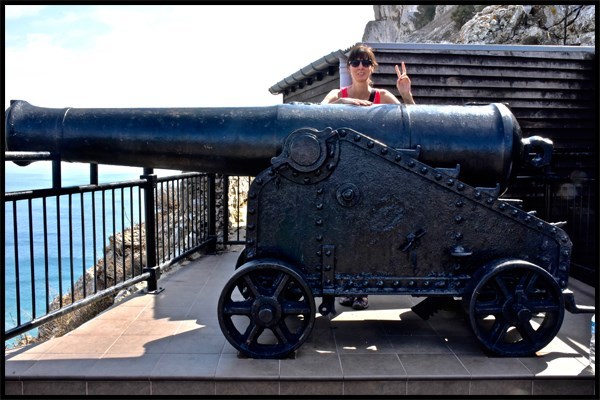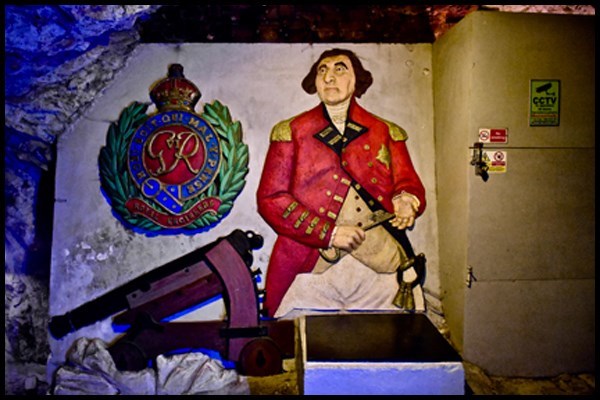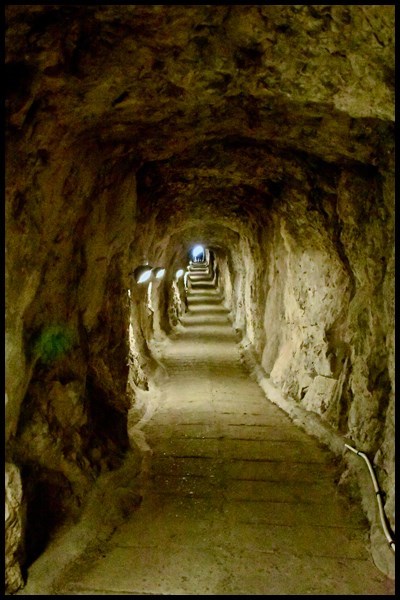
Logging Requirements:
You do not need to go inside the tunnels, everything you need is outside. In order to log this cache, you must actually visit GZ and complete the following logging requirements:
- Post a photo of yourself or your GPSr at GZ with your log, standing by the cannon at the entrance to the Great Siege Tunnels (viz. picture).
- Send me via my profile a picture, drawing or description of the marking (the cypher) which you'll find on top of this cannon. Could this gun have been used during the Great Siege? Support your statement.
- What can you see directly underneath this marking (on top of the gun about 15cm (6") below the cypher)? Describe what it is, the size, the quantity, etc.
Failing to meet logging requirements (1. through 3. above) will result in your log being deleted. So, please don't forget to do this within reasonable time of logging this find.
Note: Please do not post the answers in your log.
Cacher with the cannon at the entrance to the tunnels - sample picture.
 |
The labyrinth of tunnels known as The Great Siege Tunnels are perhaps the most impressive defence system devised by man.
At the end of the Great Siege in 1783, the defeated Commander of the French and Spanish troops, the Duc de Crillon, on being shown the fortifications that had led to the defeat of his troops, commented “These works are worthy of the Romans”. This comment highlights the ingenuity of those men who against all odds endured the onslaught of the advancing forces and were still able to devise a unique system of defence which afforded them victory.
It was during the war of American Independence, when France and Spain made an all out attempt to recapture the Rock from the British in Gibraltar’s 14th Siege, always called The Great Siege, which lasted from July 1779 to February 1783, that the then Governor General Eliott (later called Baron Heathfield of Gibraltar) is said to have offered a reward to any one who could tell him how to get guns on to a projection from the precipitous northern face of the Rock known as the Notch.

Sergeant Major Ince, a member of the Company of Military Artificers, forerunners of the Royal Engineers suggested that this could be done by tunnelling. Permission was granted, and Sergeant Major Ince started work under the direction of Lieutenant J. Evelegh, a Royal Engineer, Aide De Camp to the Governor, on May 25th, 1782.
The tunnellers relied on the strength of their arms, on their skills with a sledgehammer and a crowbar, and were also aided by gunpowder for blasting. In five weeks 18 men had driven a tunnel 8 feet square (2.40sq.m) by 82 feet long (25m) into the Rock. It is interesting to compare this with the record of a fully mechanised tunnelling company in Gibraltar during World War II, who in a week advanced 180 feet (55m)
.
Originally there was no intention of mounting guns in this gallery, but as the work progressed the fumes from repeated blasting almost suffocated the miners, so it was decided to open a vent to let air into the tunnel. Almost at once it was realised what an excellent embrasure this would make for a gun, so one was mounted without waiting to reach the ‘Notch ‘. Other embrasures were cut and guns mounted, and by the time the Siege ended in February 1783, the tunnel was 370 feet (113m) long and had four guns mounted in it. This first gallery was called ‘Windsor Gallery’. Sergeant Major Ince did not stop there - he went on to tunnel two other galleries called “Kings and Queens Lines” lower down the north face of the Rock.
Work did not stop with the end of the Siege, but instead of continuing straight towards the ‘Notch’, a tunnel was driven downwards and a large chamber opened under the ‘Notch’ called St. George’s Hall, where a battery of seven guns was installed. The Cornwallis Chamber was also excavated at this time. It was in St. George’s hall that Lord Napier of Magdala - Governor of Gibraltar - is said to have given a banquet in honour of General Grant, ex-president of the United States of America.

In gratitude to Sergeant Major Ince, he was given a Commission and granted a plot of land on the Upper Rock, still known today as Ince’s Farm. In addition, the Duke of Kent - Gibraltar’s Royal Governor and father of Queen Victoria - gave him a valuable horse, in 1802.
During the Second World War, the Royal Engineers (originally the Artificer Company during the Great Siege) including a Canadian contingent, achieved wonderful feats of engineering, adding some 33 miles (52km) of tunnels.
SOURCE:
* http://www.visitgibraltar.gi/upper-rock-great-siege-tunnels


Virtual Reward - 2017/2018
This Virtual Cache is part of a limited release of Virtuals created between August 24, 2017 and August 24, 2018. Only 4,000 cache owners were given the opportunity to hide a Virtual Cache. Learn more about Virtual Rewards on the Geocaching Blog.